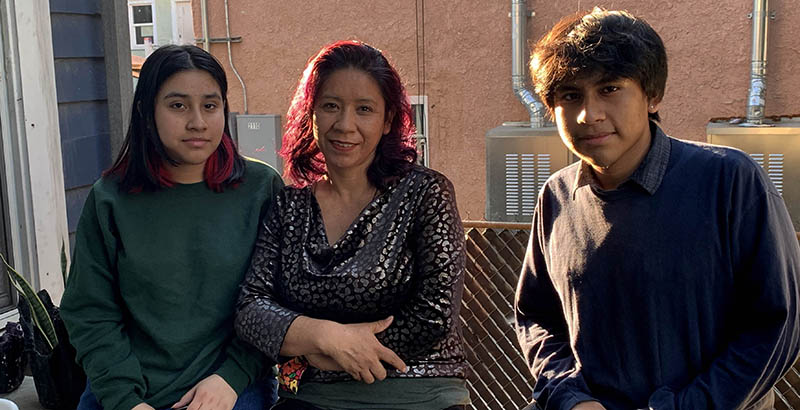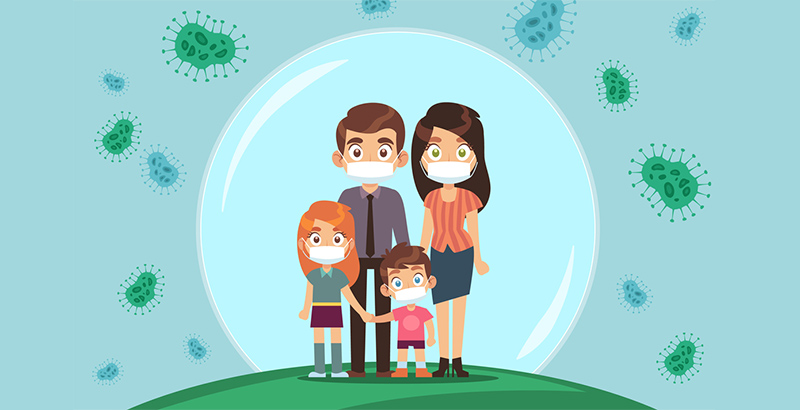The 10 Best Education Articles from March: 12 Million Students Lack Reliable Internet a Year Into Pandemic, What Herd Immunity Does (and Doesn’t) Mean for Classrooms & More
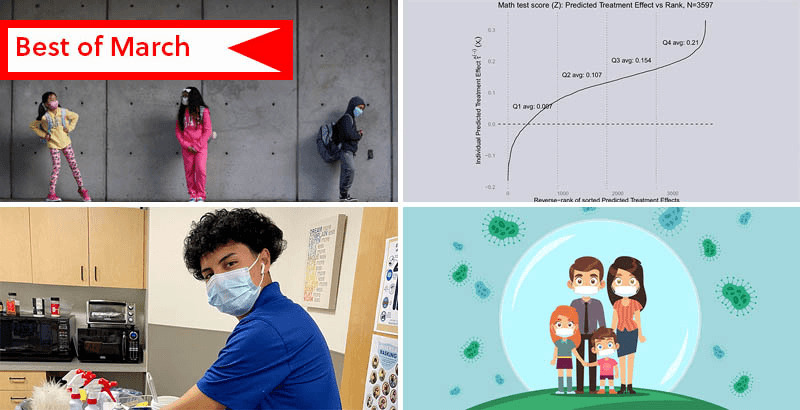
Every month, we round up our most popular and shared articles from the past four weeks. (Go deeper: See our top highlights from February, January and 2020 right here)
Has it really been a year?
It was back on March 15, 2020 when Mayor Bill De Blasio announced that America’s largest school district would shut down amid the spiraling coronavirus crisis, a definitive turning point in what would quickly become an unprecedented year of chaos for students and educators. Across several weeks this month, we reflected on the many unique storylines that emerged from the first year of the pandemic — and also looked forward at the looming fight to get our classrooms reopened and our students caught up.
Our top stories in March included a trio of anniversary features that we co-published with The Guardian, scrutinizing the country’s persistent digital divide even during a time of remote learning, examining pandemic-era school discipline policies and spotlighting the students who have had to help their families through economic hardship even as they’ve attempted to keep their education on track via virtual classes. Readers also responded passionately to our new coverage of tutoring research that could have major implications for reversing ‘COVID Slide,’ of the deployment of vaccines and what potential herd immunity does (and doesn’t) mean for schools, and a memorable profile of one Ohio school that gave students an ultimatum: Be more activa via remote learning, or return to the classroom.
Below are our most popular articles of the month. (Reminder: You can also get alerts about our latest news coverage, essays and exclusives by signing up for The 74 Newsletter)
Texas Teachers Go Door to Door as Kids Disappear From Remote Classes
Chronic Absenteeism: Middle school teacher Brandee Brandt pounded on the door of a San Antonio apartment for the third time. “It’s Ms. Brandt! Davey, are you there?” she called. Finally, Davey’s older brother cracked open the door. “You really aren’t going away are you?” he said, trying to sound annoyed as a smile tugged at the corner of his mouth. “You know we’re not giving up!” Brandt replied. Since the beginning of the school year, teachers from Rawlinson Middle School have visited around 100 homes, seeking out kids in urgent need of support and engagement. With half the school’s 1,350 students learning remotely this school year, and thus at a higher risk of chronic absence, the teachers come knocking at the first sign of trouble. “I felt a sense of urgency,” Principal Sherry Mireles said, “If they’re not getting their schooling, it’s our responsibility. “I’m not going to allow a 12-, 13-, 14-year-old to drop out. Not on my watch.” Bekah McNeel rode along and has the story. (Read the full article)
12 Months After Pandemic Closed Schools, 12 Million Students Still Lack Reliable Internet
Digital Divide: A year after the coronavirus shut down the nation’s schools, Eva Garcia’s children are among the 12 million students who either have no Wi-Fi or make do with short-term fixes to participate in remote learning. Her daughter became so stressed from getting knocked out of Zoom classes that her hair began to fall out. In the first of a three-part series produced with The Guardian to mark the first anniversary of COVID-19 school closures, The 74 examines persistent barriers to closing the digital divide: lack of broadband in rural regions, inoperable devices and families without stable housing. There is growing political pressure to solve the problem, but still so far to go. “It’s frustrating watching the state and federal government work so slowly,” Devon Conley, school board president in California’s Mountain View Whisman School District, told reporter Linda Jacobson. “In the grand scheme of things, internet access shouldn’t be just for students. I think it’s a human right.” (Read the full article)
Study: Chicago Tutoring Program Delivered Huge Math Gains; Personalization May Be the Key
Accelerating Learning: An abundance of research has demonstrated the power of tutoring in boosting students’ academic performance. Now, as families and governments seek the best ways to reverse COVID-related learning loss, a new working paper points to some of the most impressive tutoring results yet recorded — and offers a theory about how they were achieved. In two experimental trials in Chicago, the authors find that ninth- and 10th-graders saw huge improvements both in their math test scores and their grade-point averages, with course failures reduced by as much as 49 percent. Particularly impressive, according to co-author Monica Bhatt, is that the effects were generated by a program serving older students, who often see weaker results from education interventions. “I really do think we have to stop asking ourselves, ‘Well, what really works?’ because we have more indications of what works,” Bhatt told The 74’s Kevin Mahnken. “Now we have to figure out how to actually do it in the context of U.S. public schooling.” (Read the full article)
‘A Lot of Them Choose Work’: As Teens Pile on Jobs to Help Their Families, Schools Strive to Keep Tabs on Students They Haven’t Seen in a Year
Remote Learning: For many teens, the past year has been about much more than keeping up with school. Managing cleaning jobs, launching a bakery business and learning how to coach baseball are among the adult roles that students have taken on to help out their families during the pandemic. But the pressure can be too much. “I get stressed and I know my mom can see it … because she sometimes tells me to leave my job to focus on school,” Oakland, California, senior Yasmine Esquivel said. As kids adapt, many of their teachers and schools are improvising as well, from extending deadlines to creating entirely new programs to stay in touch. Many students face a tough choice. “Do I want to … survive school or survive life?” said Jay Novelo, who works at Tyee High School near Seattle and checks in weekly with 14 students. “I can’t blame the students — a lot of them choose work.” (Read the full article)
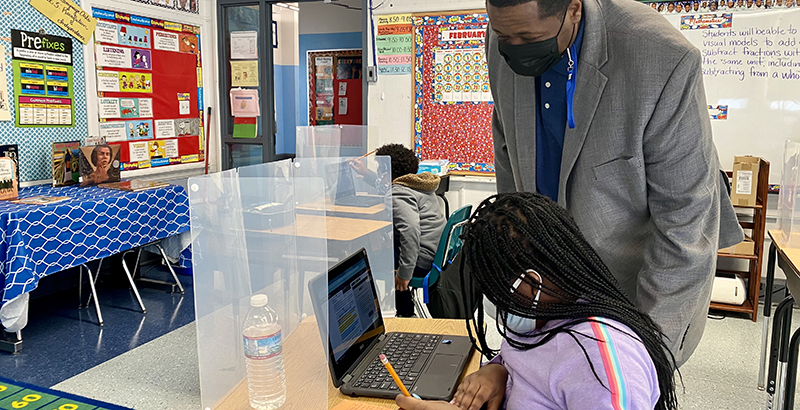
Bucking the Trend: How 2 D.C. Principals Restored Black Parents’ Trust in Returning Kids to the Classroom
Parent Engagement: At Garfield Prep Academy in Washington, D.C.’s majority Black Ward 8, Principal Kennard Branch has been pulling out all the stops to make worried parents more confident about sending their children back to school: He’s posted self-produced video tours of the building online, secured plastic shields for every desk and is sending kids home with bagged dinners. Principal Katreena Shelby at nearby Kramer Middle School provides parents with one-on-one building walkthroughs upon request and answers their questions through text messages and calls on her personal cell phone. At both schools, more students have returned for in-person learning — and the principals believe these efforts at family outreach are the reason why. “It has been a struggle districtwide to really get parents interested in sending their students back,” Shelby told The 74. “Our school culture plays a large role in [our momentum]. … Relationships and rapport have helped us.” (Read the full article)
As Adults Move Toward Herd Immunity, Could an Unexpected COVID Side Effect Be Kids Unable to Fight Off Germs Long-Term?
School Safety: After nearly a year of disastrous COVID-19 news, it emerged in mid-February like a light at the end of the tunnel: Infections began falling and herd immunity, some experts said, could spell the end of the pandemic in the not-so-distant future. At the same time, virologists were beginning to conclude that complete eradication of COVID appears unlikely, and that the virus could circulate in pockets of the globe for years to come. Health experts say a return to pre-pandemic normal may not be possible for schools in 2021-22, so they will likely need to remain vigilant into the fall, Asher Lehrer-Small reports. “We can’t just assume that come Sept. 1, we’re going to walk back in [to school] masks off and everything’s going to be like it was in 2019,” said Boston University associate professor of epidemiology Benjamin Linas. “For the fall, we should expect to be 100 percent in-person learning in our buildings still wearing masks.” (Read the full article)
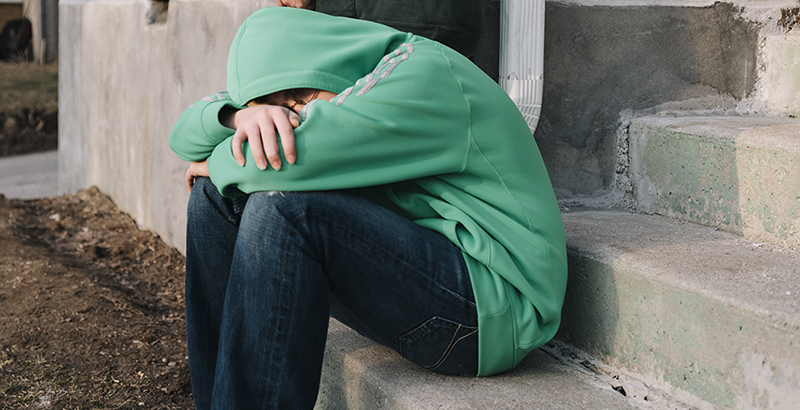
Families Face Steep Truancy Fines, Contentious Court Battles As Pandemic Creates School Attendance Barriers
Student Discipline: On the Monday before Thanksgiving, a police officer showed up on Tracie Higgins’s doorstep in Manitowoc, Wisconsin, and handed her teenage son a $439 fine for missing too many days of remote school. The repeated absences, she protested, were the result of faulty school technology, including a Chromebook that wouldn’t charge. Parent Debra Pratt had a similar experience: Her son was fined for racking up 28 absences that the school district had marked as unexcused — including on the day he tested positive for COVID-19. Similar feuds between frustrated parents and overwhelmed school administrators are playing out across the country as the pandemic’s academic disruptions reach the one-year mark. But punitive approaches to addressing “truancy,” experts say, exacerbate the pandemic-induced challenges confronting many households, from economic instability to mental health crises. “I think it’s ridiculous, absolutely ridiculous, especially during a pandemic, when there’s just too many other factors that are playing into this,” Pratt said. And experts don’t expect student disengagement to subside when the virus does. Read more from The 74’s Mark Keierleber.
Education Disrupted: 52 Unforgettable Weeks For Students & Schools Captured in 52 Iconic Photos
Photo History: Fifty-two weeks ago, the pandemic swept through the nation, closing schools one after the next like a relentless set of dominoes. These 52 photos, compiled by The 74’s Meghan Gallagher, show just how much the year changed educators’ and students’ lives. They are a haunting time capsule revisiting solemn scenes and sadness across the education landscape — masked students, sports without spectators, dining rooms turned into classrooms and socially distanced lunch periods. But these pictures also show students, their families and educators in moments of resilience and inspiration, reflecting how Americans found new ways to celebrate such milestones as graduations. The images are a reminder that it has been a school year like no other, one we won’t soon forget. (See the full photo essay)
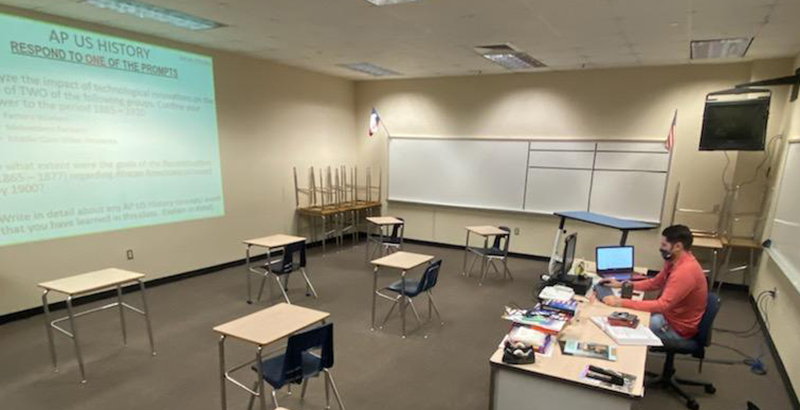
‘Teacher Cams’ Could Revolutionize Education After the Pandemic Ends, But Some Critics See a Massive Student Privacy Risk
Student Privacy: On any given day, most students in Houston high school teacher Trevor Toteve’s class appear as static, black boxes. As they tune in remotely, he doesn’t require them to use their webcams due in part to student privacy concerns. Many students, he found, lack a quiet space at home to participate in school or are homeless. Yet teachers across the U.S. don’t allow that flexibility, relying on school policies that require students to use webcams for remote learning during the pandemic. The practice, some argue, has created a sense of cohesion at a time of widespread isolation and allows teachers to ensure students are paying attention. In fact, some say, webcams should play a major role in the post-pandemic education landscape. Yet where some see innovation that’s long overdue, others see a student privacy nightmare. In some cases, advocates argue, school webcam mandates could violate the Constitution. (Read the full article)
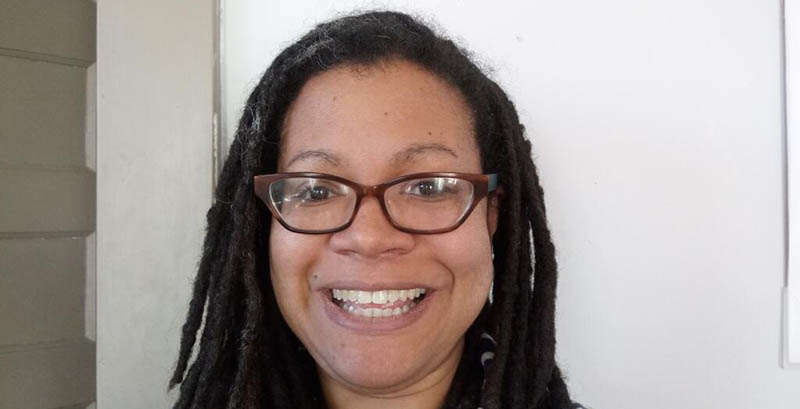
Two Steps Forward, One Back: Teacher Diversity Bill May Push Hundreds of Minnesota Educators of Color from Classrooms
Teacher Diversity: Originally dubbed the Increase Teachers of Color Act, a bill making its way through the Minnesota House of Representatives contains a smorgasbord of measures aimed at diversifying its 95 percent-white teacher corps. But it also would eliminate a credentialing system that has enabled hundreds of teachers of color and Native American educators to enter the profession. Many are on the verge of earning permanent licenses, but they could be forced out altogether instead, Beth Hawkins reports. “It’s ironic,” says high school teacher N’Jai-An Patters, whose Ph.D. won’t save her job if the change takes place. “On the one hand, here are all these things we are going to do to increase teacher diversity. But at the same time, we are not going to do these things that are working toward diversifying.” (Read the full article)
Get stories like these delivered straight to your inbox. Sign up for The 74 Newsletter

;)

